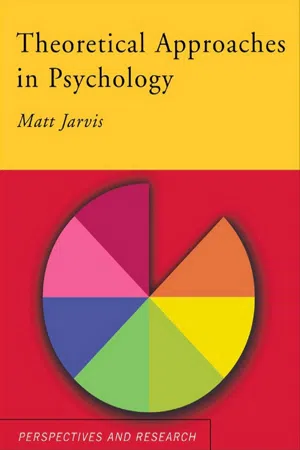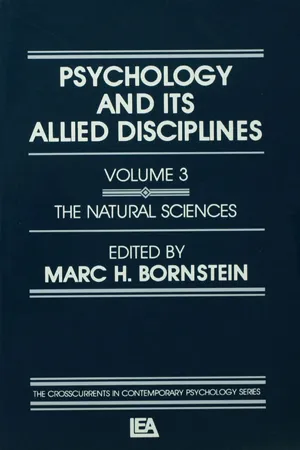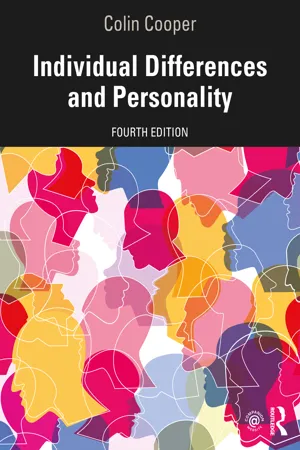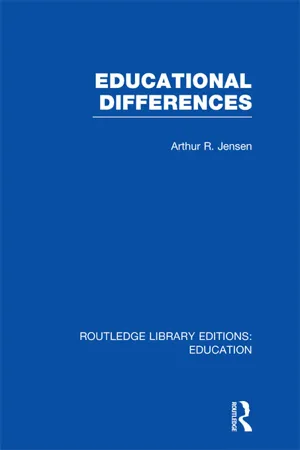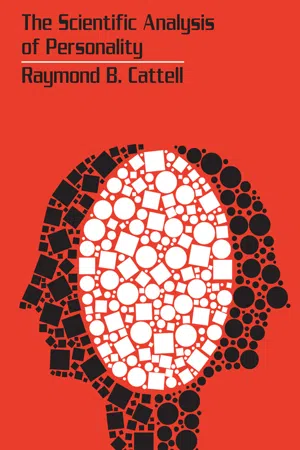Psychology
Heritability
Heritability refers to the extent to which differences in a trait within a population can be attributed to genetic factors. It is a statistical concept that quantifies the proportion of individual differences in a specific trait that can be attributed to genetic variation. Heritability estimates can help researchers understand the relative contributions of genetic and environmental factors to the development of traits or behaviors.
Written by Perlego with AI-assistance
Related key terms
Related key terms
1 of 4
Related key terms
1 of 3
11 Key excerpts on "Heritability"
- eBook - ePub
Psychological Criminology
An Integrative Approach
- Richard Wortley(Author)
- 2023(Publication Date)
- Routledge(Publisher)
The complexity of the gene-behaviour relationship is further increased by the fact that the expression of genetic traits is significantly affected by the environment, and particularly so in the case of polygenic traits. This point can be clearly illustrated by considering the case of height. A seed planted in fertile ground will grow more vigorously than a genetically identical seed planted in barren ground. Likewise for humans, a person may inherit genes for tallness from both parents, but how tall the person grows will depend heavily on environmental factors such as nutrition, exercise, pollution, climate, and standard of living. It is because of such environmental factors that people today are much taller generally than they were in medieval times, and taller even than they were one or two generations ago.The extent to which variations in a given trait are inherited is referred to as its Heritability. Heritability is expressed as a coefficient that reflects the sources of variance in a population. For example, the Heritability for human height in a particular sample has been estimated at .8 (Visscher et al., 2006 ). This means that when accounting for the height differences among individuals, 80% can be attributed to genes, with the remaining 20% to environmental factors. In humans, Heritability is usually estimated using twin and adoption studies designed to tease out the relative contributions of genetic and environmental factors. However, the exact methods used to calculate Heritability coefficients can involve statistical models, the precise details of which need not concern us here. (Those readers wishing to follow up on the underlying statistics of the Heritability coefficient can be ‘walked through’ the basic computations by Walsh, 2009 , p. 34.)Heritability is a term that is frequently misinterpreted, so it is important to clarify several issues. First, Heritability is not a measure of the extent to which genes contribute to an attribute; it is a measure of the contribution of genes to variations - eBook - ePub
- Matt Jarvis(Author)
- 2005(Publication Date)
- Routledge(Publisher)
influences, but on human similarity rather than difference. Thus the reason people generally like to go to the toilet alone could be explained from an evolutionary perspective as having evolved in order to prevent picking up germs from other people’s excreta.Let us now go on to look at behavioural genetics in detail, focusing on the issue of the extent to which intelligence is genetically determined. We can then look at evolutionary psychology, focusing on the possible evolutionary basis of our abilities in infancy and of adult social behaviour. We can then look at the contemporary issue of whether behavioural genetics poses a threat to the other approaches to psychology.Behavioural genetics: the genetics of individual differences
Behavioural genetics is the study of the origins of the psychological differences between people. There are essentially two factors that can affect individual differences: genes and environment. These are sometimes called ‘nature’ and ‘nurture’ because your genetic make-up is determined by biology (hence nature), whereas your environment is controlled principally by other people (hence nurture). The nature-nurture debate is the general debate in psychology about the relative importance of genes and environment. Behavioural geneticists research the importance of both nature and nurture. Don’t fall into the common trap of assuming that behavioural geneticists are out to prove we are entirely controlled by our genes.We all share about 99.9 per cent of our genes—that is what makes us human. When we talk about genetic differences between individuals we are talking of just 0.1 per cent of our genes. None the less, this is sufficient to account for substantial differences between people. Characteristics that are largely under the control of genes are said to be high in Heritability - eBook - ePub
Psychology and Its Allied Disciplines
Volume 3: Psychology and the Natural Sciences
- M. H. Bornstein(Author)
- 2013(Publication Date)
- Psychology Press(Publisher)
Problems with these procedures on the psychological side include the validity, stability, and precision of phenotypic measures and of measures of the environment. Psychology also lacks a quantitative theory for measuring environmental variables on a quantitative scale. Genetics is ahead in having a sound theoretical basis for determining the degree of relationship between pairs of individuals. However, there are plenty of problems on the genetic side including: errors in distinguishing MZ and DZ twin pairs; errors in the assignment of paternity; genotypeenvironment correlations; and genotype-environment interactions. These issues are discussed extensively by Eaves, Last, Young, and Martin (1978) who point to a growing flexibility in the formulation of models for analysing the sources of human behavioral variation. Much of the advance in data analysis stems from new statistical and computing procedures that permit more complex and imaginative models that allow the effects of interfamilial environment, genetic relationship, age changes, and the like to be factored in. The new wave is not particularly concerned with the Heritability of a trait for itsown sake: However, the debate over Heritability of human traits has been so vigorous that the meaning of the term requires attention.HeritabilityThe concept of Heritability originated from efforts to improve procedures for breeding plants and animals for the benefit of humans. Only if a desired trait were reliably transmitted from parents to offspring would selection be practical. In measuring Heritability, the total phenotypic variance (V p ) of a population is divided between a genetic (V g ) and an environmental (V e ) component. Broad Heritability, better called degree of genetic determination , is an indicator of the relative contribution of gene differences to phenotypic variation in a population. The relationship is symbolized as: . Narrow Heritability, ,is a measure of the predictability of an individual's phenotype given knowledge of the phenotypes of close relatives. Narrow Heritability is much more meaningful for predicting the efficacy of selection. In its computation Vg is divided into an additive component Va and a dominant component Vd (Falconer, 1960; Roberts, 1967). Heritability in the narrow sense is: Va / (Va + Vd + Ve - eBook - ePub
- J.N. Spuhler(Author)
- 2017(Publication Date)
- Routledge(Publisher)
This is, to some extent, what the results show. Exceptions to this rule may be made more understandable if we rephrase the sentence somewhat and think of this continuum as concerned with an increasing involvement of the central nervous system as against more peripheral structures. Structural and more or less permanent functional differences may exist between individual nervous systems, which are themselves genetic in origin and which may affect certain aspects of personality more than other aspects; this would explain apparent departures from the expected progressive decline in importance of hereditary factors as we move “in” and “up.” To avoid awkward circumlocutions I will frequently use the term “Heritability” as shorthand for the statement that a trait is under some degree of hereditary control, even though no precise measure of Heritability exists for man. The conclusion that a trait shows Heritability or some amount of Heritability is based on statistical evidence, so that we encounter the usual questions of whether the sample is representative of the population, whether the mathematical model bears an adequate relation to physical reality, how efficient the statistic is, and so forth. I will not discuss these topics, mostly because I am not competent to do so. I will merely mention here the most frequently used techniques for deciding whether a trait has an important hereditary component. Holzinger devised an Heritability index, h 2, of the proportion of the variance due to heredity based either on subtracting correlations from one another or in another formula subtracting variances from one another. The index has been criticised as statistically and genetically not quite correct. As serious perhaps is the fact (for which the author cannot be blamed) that the index is frequently misinterpreted, so that results of studies that used this index are frequently misquoted - eBook - ePub
- Colin Cooper(Author)
- 2020(Publication Date)
- Routledge(Publisher)
Chapter 15Environmental and genetic determinants of personality and abilities
Introduction
Empirical studies of the extent to which personality and ability can be inherited provide valuable evidence as to the relative importance of biological and social factors in development. It is often claimed that intelligence is substantially inherited – but what about personality? And how strong and consistent is the evidence? If genes influence levels of some trait, does this mean that all children in a family will closely resemble their parents? This last interpretation is both widely believed and incorrect, as will be shown below.There are three other issues, too. First, studying Heritability can also show whether individual differences are ‘real’ characteristics of organisms (as trait/biological theorists would argue), or whether personality is a social construction – an inference drawn by others that need have no basis in the biology of the individual, and which need not even accurately reflect their behaviour. Second, it is useful to reflect on what the implications of strong environmental or strong genetic influences on personality might be for society. If personality and abilities were completely determined by social factors, would this always be desirable? What would be the consequences if genetic makeup influences personality or abilities? Finally, what about the interaction between environment and genetic influences? We know that genes can only influence behaviour given appropriate environmental conditions, but do adults and children tend to encounter the types of environment which will allow any genetic potential to turn into behaviour? - eBook - ePub
- Arthur Jensen(Author)
- 2012(Publication Date)
- Routledge(Publisher)
Heritability and teachability
Heritability and teachability
It has been said that the Heritability of learning ability or of intelligence is irrelevant to teachability, or as the Bulletin of the ERIC Information Retrieval Center on the Disadvantaged (1969, 4, no. 4) printed in boldface: ‘Teachability is not a function of Heritability’. In support of this statement we see it pointed out that a child or a group of children show some response to training, and this is held up as evidence against the Heritability of intelligence or learning ability.Heritability (h2 ) is a technical term in genetics which refers to the proportion of the population variance in a phenotypic characteristic or measurement that is attributable to genetic variation. It has also been called the coefficient of genetic determination. It can take any value from 0 to 1. It is not a constant but differs for different traits, different measurements, and in different populations. Its value can be estimated by a number of methods in quantitative genetics. Like any population statistic, it is subject to measurement error and sampling error. Since it is based essentially on the analysis of variance, it can tell us nothing at all about the causes of the particular value assumed by the grand mean of the population. It only analyzes the variance (or squared deviations) about the grand mean. And it tells us what proportion of this total variance is genetic variance and what proportion is non-genetic, i.e., due to environmental factors of all kinds and to errors of measurement. Most estimates of the Heritability of IQ in the European and North American populations on which we have good data fall in the range from 0·60 to 0·90 and most of these estimates are in range from 0·70 to 0·80 (not corrected for test unreliability).The fact that IQ has high Heritability surely does not mean that individuals cannot learn much. Even if learning ability had 100 per cent Heritability it would not mean that individuals cannot learn, and therefore the demonstration of learning or the improvement of performance, with or without specific instruction or intervention by a teacher, says absolutely nothing about Heritability. But knowing that learning ability has high Heritability does tell us this: if a number of individuals are all given equal opportunity – the same background, the same conditions, and the same amount of time – for learning something, they will still differ from one another in their rates of learning and consequently in the amount they learn per unit of time spent in learning. That is the meaning of Heritability. It does not say that individuals cannot learn or improve with instruction and practice. It says that given equal conditions, individuals will differ from one another, not because of differences in the external conditions but because of differences in the internal environment which is conditioned by genetic factors. ‘Teachability’ presumably means the ability to learn under conditions of instruction by a teacher. If this is the case, then it is true that Heritability has nothing to do with teachability. But was this ever really the question? Has anyone questioned the fact that all school children are teachable? The important question has concerned differences in teachability – differences both among individuals and among sub-groups of the population. And with reference to the question of differences - eBook - ePub
Intelligence
The Psychometric View
- Paul Kline(Author)
- 2013(Publication Date)
- Routledge(Publisher)
Chapter Six Heritability of IntelligenceThe Heritability of intelligence is a subject which, unlike many academic topics, creates deep feelings in those who become engaged in it. To introduce the topic I need to make a few general points and to reduce the emotional aspects of the argument to ensure a dispassionate view.I intend to examine the evidence from one particular approach to the subject, that of biometrics. This is the study of the sources of variance within populations with reference to genetic and environmental components. It must be noted at the outset that when the findings indicate, for example, that 50 per cent of the variance for a given trait, perhaps intelligence, is attributable to genetic factors, it does not mean that half of the intelligence in an individual is genetically determined and the rest by her environment. These figures refer to the sources of variation within the population. Similarly if within a population some trait is genetically determined it does not mean that differences between populations on the trait must be so determined, as Plomin (1986) has explicated. As will be seen later in this chapter and in other sections of this book, these points are important.This topic appears to be factual, in that it is an empirical matter, partitioning the variance into genetic and environmental components. Yet there are huge differences in conclusions ranging from Kamin’s claim (1974) that there is no evidence that a rational person could cite to indicate that genetic factors determine individual differences in intelligence to the work of Cattell (1971) who would argue that about 70 per cent of the population variance is genetically determined. So that the argument, for the reader, does not become one simply of belief it will be necessary to set out the bases of biometric methods, the logic of which is remarkably clear. - eBook - ePub
- Raymond B. Cattell(Author)
- 2019(Publication Date)
- Routledge(Publisher)
It depends on the racial group studied and the range of environmental, inter-familial difference at the time. As stated above, if we take a very mixed racial group and smooth out environmental differences the ratio will rise somewhat in favour of heredity, while the converse will hold when social conditions are such as to produce big environmental differences. Not many nature-nurture ratios have been computed, but those which have range all the way from giving most of the weight to heredity, as intelligence, personal tempo and colour vision, to others which give most weight to environment, as in arithmetical skill, various dexterities in games and spelling. It may be necessary to remind the student here that a skill which is wholly acquired can yet be determined in its level partly by heredity. Whether you learn English or French as your native tongue depends wholly on environment; the level of skill you reach in either of these is partly influenced by hereditary capacity. It is possible to show a mentally defective command of language in many different languages. An alternative approach to heredity and one which must supplement the nature-nurture formulation if we are to have an illuminating understanding of problems is that which looks for inheritance by genes. We cannot spend more time, since our main interest is in psychology, on the concepts and methods of heredity study as such, and we shall assume that the student knows about the unitary heritable influences called genes and the Mendelian laws on the interaction of dominants and recessives. Here the psychologist looks for a set of personality manifestations which are transmitted in a family as a single set of cohering qualities, though the pattern may sometimes be smudged or faded through environmental influence. This set will presumably be due to a single gene in the germ plasm. An individual will either have it as a whole, no matter how modified by environment, or not at all - eBook - ePub
- J. Peter Rothe, J. Peter Rothe(Authors)
- 2017(Publication Date)
- Routledge(Publisher)
how much each contributes.At this point, therefore, let us turn from our brief survey of the environmental, learning influences in personality to the hereditary, genetic influences. PRINCIPLES AND ILLUSTRATIONS OF EVALUATING HEREDITY AND ENVIRONMENTAL INFLUENCEIt might seem most logical, in any case, to begin with heredity when studying personality because this defines the beginning of the person. However, the influences of heredity do not always come at birth, as witness the appearance of the sex drive at puberty, or of some special hereditary form of deafness or palsy to a middle-aged man. As we actually observe a developing personality it is often quite impossible to distinguish an externally initiated process of learning from an internally determined process of maturation. Yet, as we shall see, there are ways of at least saying how much of some total change or difference is due respectively to learning and maturation.Geneticists seek to boil down the truths and lawful relations of heredity mainly in two ways: (1) in terms of Mendelian laws stating that such and such a trait is determined by one, two, or more genes, that one of a pair of contrasting characters is dominant to another, and a second recessive, and so on; (2) in terms of what the statistician calls variance analysis, directed to stating the fraction of the observed variability (strictly the square of the standard deviation) contributed respectively by heredity and environment. For example, one can conclude that roughly four fifths of the differences we measure on intelligence tests would disappear if people were all of identical heredity, whereas two thirds of the variance on extraversion-introversion would vanish if all people were brought up identically.With respect to physical traits, e.g. eye colour, number of fingers (for some people do - eBook - ePub
- N.H. Pronko, J.W. Bowles(Authors)
- 2013(Publication Date)
- Routledge(Publisher)
This is a practical matter, not one of theoretical embarrassment, as is true of the competing hereditary theory. When one considers how many family lines do not show a succession of geniuses but only a sporadic individual showing behavioral superiority, one wonders how the traditional hereditary dogma can persist in the face of such facts. Note that most often there is only one Beethoven, one Tchaikovsky, one Edison, Bell, Marconi, Toscanini, da Vinci, Gutenberg, and so on, in an otherwise consistently mediocre lineage. Indeed, it is a commonplace observation that the world’s outstanding men have come from humble ancestry. Who can formulate the hereditary “principle” that operates in such a strange, erratic manner?Here another point of valid criticism obtrudes itself. Biology has long ago given up the theory of the inheritance of acquired characteristics. Nevertheless, “psychohereditary” doctrine persists in full force. The belief that parents “pass on” their “traits” to their offspring is an unwitting assumption of popular psychology’s stand on this problem. Several interesting questions suggest themselves. Have the “genes” representing these “capacities” always been present in the human species or (assuming a theory of evolution) in its precursors? If so, have there always been “genes” for musical and mathematical ability even before these disciplines came into being? And do humans today possess “genes” for performances on yet-to-be-discovered instruments? How did these “genes” get in? When? Are they not just so many words—terms without referents?SUMMARY . This brief treatment of the relationship of heredity and psychology has pointed out how an error was perpetrated when the term “heredity” was taken into science with all its non-scientific connotations. We then tried to find some fact in nature to which this term might refer, and we showed that animals that begin life as a cell contributed by members of a certain species will look (more or less) like other members of that species. This material might be called hereditary. Since it differs in different species, it gives rise to animals with different structures which enter into behavioral events as factors of advantage or disadvantage in the acquisition of various behaviors.Popular psychology has claimed that musical and certain other behaviors must be treated differently from most other reactions in that the former have a hereditary basis. Examination of this theory reveals circular reasoning—reductio ad absurdum; - eBook - ePub
- Peter Mitchell, Fenja Ziegler(Authors)
- 2013(Publication Date)
- Psychology Press(Publisher)
11 DOI: 10.4324/9780203736357-11Contents
Introduction What is inherited? Intelligence: Heredity versus environment Describing and testing the concept of intelligence Problems with testing intelligence Heritability of intelligence Evaluating the twin studies Environmental factors and IQ The social environment IQ, elitism, and racism SummaryThe role of heredity and environment in intelligence 11
Chapter Aims- To introduce the concept of intelligence
- To introduce ways in which intelligence is measured.
- To assess the roles of nature and nurture in intelligence.
- To highlight some of the problems faced when testing intelligence.
Introduction
Intelligence really matters to people’s lives; those that are deemed intelligent are perceived to be cut out for better jobs and more prosperous and fulfilling lives. The idea of intelligence as a measurable entity is only about a 100 years old, and yet it is firmly ingrained in our folk psychological perception of ourselves and others that we can be ranked in terms of our intelligence. One of the central questions that researchers have investigated is whether intelligence is inherited or whether it is a result of education and other environmental factors, in other words, it figures in the nature–nurture debate. Unlike some other topics, this debate reaches beyond the realms of academia and pure scientific interest because intelligence is assigned such high status in our society and, moreover, it has implications for educational and social policy. In this chapter we look at how intelligence is measured and reflect on the role of nature and nurture.What is Inherited?
Before we look specifically at intelligence, it is worthwhile establishing more generally whether there is some way of telling which part of the way we are, and the way we behave, is determined by the genes passed on to us from our parents. At a glance, this may seem a simple question to answer. All we have to do is watch newborn babies: They have had little or no time to learn and so presumably whatever they can do is determined genetically, and therefore is likely to be inherited from the mother, the father, or both. By observing newborns we could compile a long list of behaviors: crying, swallowing, blinking, defecating, sucking, yawning, sneezing, coughing, grasping, etc.
Index pages curate the most relevant extracts from our library of academic textbooks. They’ve been created using an in-house natural language model (NLM), each adding context and meaning to key research topics.
Explore more topic indexes
Explore more topic indexes
1 of 6
Explore more topic indexes
1 of 4

